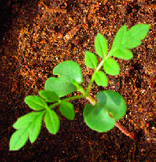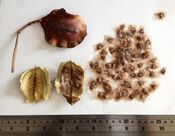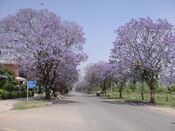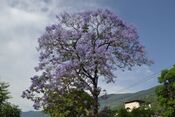Biology:Jacaranda
| Jacaranda | |
|---|---|

| |
| A flower of Jacaranda mimosifolia | |
| Scientific classification | |
| Kingdom: | Plantae |
| Clade: | Tracheophytes |
| Clade: | Angiosperms |
| Clade: | Eudicots |
| Clade: | Asterids |
| Order: | Lamiales |
| Family: | Bignoniaceae |
| Tribe: | Jacarandeae |
| Genus: | Jacaranda Juss. |
| Type species | |
| Jacaranda mimosifolia | |
Jacaranda is a genus of 49 species of flowering plants in the family Bignoniaceae, native to tropical and subtropical regions of the Americas[1] while cultivated around the world. The generic name is also used as the common name.
The species Jacaranda mimosifolia[2] has achieved a cosmopolitan distribution due to introductions, to the extent that it has entered popular culture. It can be found growing wild in Central America, the Caribbean, Spain, Portugal, southern and northern Africa, China, Australia, Rwanda and Cyprus.
Etymology
The name is of South American (more specifically Tupi-Guarani) origin, meaning fragrant.[3] The word jacaranda was described in A supplement to Mr. Chambers's Cyclopædia, 1st ed., (1753) as "a name given by some authors to the tree the wood of which is the log-wood, used in dyeing and medicine" and as being of Tupi-Guarani origin,[4][5] by way of Portuguese.Cite error: Closing </ref> missing for <ref> tag
- Jacaranda intricata A.Gentry & Morawetz
- Jacaranda irwinii A.Gentry
- Jacaranda jasminoides (Thunb.) Sandw.
- Jacaranda macrantha Cham.
- Jacaranda macrocarpa Bur. & K.Schum.
- Jacaranda micrantha Cham.
- Jacaranda montana Morawetz
- Jacaranda morii A.Gentry
- Jacaranda mutabilis Hassl.
- Jacaranda obovata Cham.
- Jacaranda oxyphylla Cham.
- Jacaranda paucifoliata Mart. ex DC.
- Jacaranda puberula Cham.
- Jacaranda racemosa Cham.
- Jacaranda rufa Manso
- Jacaranda rugosa A.H.Gentry
- Jacaranda simplicifolia K.Schum.
- Jacaranda subalpina Morawetz
- Jacaranda ulei Bur. & K.Schum.
Cultivation

Jacaranda can be propagated from grafting, cuttings, and seeds, though plants grown from seeds take a long time to bloom. Jacaranda grows in well-drained soil and tolerates drought and brief spells of frost and freeze.[6][7]
This genus thrives in full sun and sandy soils, which explains their abundance in warmer climates. Mature plants can survive in colder climates down to −7 °C (19 °F); however, they may not bloom as profusely. Younger plants are more fragile and may not survive in colder climates when temperatures drop below freezing.
Uses
Several species are widely grown as ornamental plants throughout the subtropical regions of the world, valued for their intense flower displays. The most often seen is the blue jacaranda (Jacaranda mimosifolia; syn. J. acutifolia hort. non Bonpl.). Other members of the genus are also commercially important; for example the Copaia (Jacaranda copaia) is important for its timber because of its exceptionally long bole.
Gallery
-
Flowers of Jacaranda ulei
-
Jacaranda seeds
-
Jacaranda tree blooming in India
References
- ↑ Gentry, A. W.; Morawetz, W. (1992). "Bignoniaceae: Part II (Tribe Tecomeae)". Flora Neotropica 25 (2): 51–104.
- ↑ "Jacaranda mimosifolia D.Don". https://powo.science.kew.org/taxon/urn:lsid:ipni.org:names:130936-2.
- ↑ "Jacaranda mimosifolia - Parcs i Jardins - Itineraris". bcn.cat. http://mediambient.itineraris.bcn.cat/en/node/259/365.
- ↑ Oxford English Dictionary 2nd Ed. (1989)
- ↑ "Jacaranda". Online Etymology Dictionary. http://www.etymonline.com/index.php?l=j&allowed_in_frame=0.
- ↑ "Jacaranda Tree". The Lovely Plants. http://www.thelovelyplants.com/jacaranda-tree/.
- ↑ "Jacaranda Tree". https://www.wikilawn.com/drought-tolerant-plants/jacaranda-tree/.
External links
- Dos Santos, G., & Miller, R. B. (1997). "Wood anatomy of Jacaranda (Bignoniaceae): Systematic relationships in sections Monolobos and Dilobos as suggested by twig and stem rays" (PDF file). IAWA Journal 18: 369–383. .
- Goodna Jacaranda Festival at Evan Marginson Park, Goodna
- Agroforestry Tree Database
- Jacaranda Festival, Grafton;
Wikidata ☰ Q311105 entry
 |





